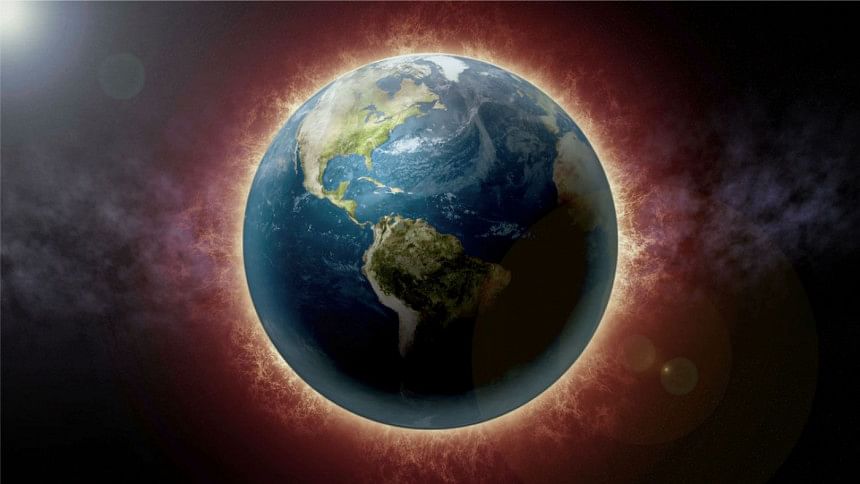Global warming is impacting how Earth spins on its axis

Anthropogenic greenhouse gas emissions might be affecting more than just the climate. For the first time, scientists at NASA presented evidence that the orientation of the Earth's spin axis is changing because of global warming.
The Earth spins from west to east about an axis once every 24 hours, creating the continuous cycle of day and night. The north-south spin axis runs through the North and South Poles and is tilted by 23.5 degrees from the vertical. The axial tilt causes almost all the seasonal changes.
But the tilt is far from constant. It varies between 21.6 and 24.5 degrees in a 41,000-year cycle. This variation together with small fluctuations in the Sun and Moon's gravitational pull, oblate shape and elliptical orbit of the Earth, irregular surface, non-uniform distribution of mass and movement of the tectonic plates cause the spin axis, and hence the Poles, to wobble either east or west along its general direction of drift.
Until 2005, Earth's spin axis has been drifting steadily in the southwest direction around ten centimeters each year towards the Hudson Bay in Canada. However, in 2005, the axis took an abrupt turn and started to drift east towards England at an annual rate of about 17 centimeters, according to data obtained by NASA's Gravity Recovery and Climate Experiment satellites. It is still heading east.
After analysing the satellite data, scientists at NASA's Jet Propulsion Laboratory in California attribute the sudden change in direction of the axis mainly to melting of Greenland's ice sheets due to global warming. The reason: Melting of ice sheets and the resulting rise of the sea level are changing the distribution of mass on Earth, thereby causing the drift of the spin to change direction and become more oblique. The axis is particularly sensitive to changes in mass distribution occurring north and south of 45 degrees latitude. This phenomenon is similar to the shift in the axis of rotation of a spinning toy if we put more mass on one side of the top or the other.
Since 2002, ice sheets of Greenland have been melting at an annual rate of roughly 270 million tonnes. Additionally, some climate models indicate that a two-to-three degrees Celsius rise in temperature would result in a complete melting of Greenland's ice sheets. If that happens, it could release the equivalent of as much as 1,400 billion tonnes of carbon dioxide, enhancing global warming even further. It would also raise the sea level by about 7.5 meters. By then, the wobbling of the Poles would also be completely out of whack.
The ice in the Arctic Ocean has also decreased dramatically since the 1960s. For every tonne of carbon dioxide released into the atmosphere, about three square meters of Arctic's ice were lost in the last 50 years. This reflects a disquieting long-term trend of around ten percent loss of ice per decade. Furthermore, Antarctica is losing more ice than is being replaced by snowfall. The influx of water from the melting of ice of the Arctic Ocean and Antarctica together with the melting of glaciers and the subsequent redistribution of water across the Earth is also causing our planet to pitch over.
What does this mean for us? Although something as small as we humans shook up something as massive as the Earth, it won't turn upside down as long as the Moon, which acts as a stabiliser of the Earth's spinning motion, stays in the sky as our nearest neighbour. However, if the shift of the spin axis maintains its present rate and direction, then by the end of this century, the axis would shift by nearly 14 meters. Such a large shift will have devastating consequences for climate change and our planet.
The orientation of the Earth's spin axis determines the seasonal distribution of radiation at higher latitudes. If the axial tilt is smaller, the Sun does not travel as far north in the sky during summer, producing cooler summers. A larger tilt, as could be in the future, would mean summer days that would be much hotter than the present summer days. In addition, it would impact the accuracy of GPS and other satellite-dependent devices.
Since global warming is causing the Earth's mass to be redistributed towards the Poles, it would cause the planet to spin faster, just as an ice skater spins faster when she pulls her arms towards her body. Consequently, the length of a day would become shorter.
Our biological clock that regulates sleeping, walking, eating, and other cyclic activities is based on a 24-hour day. Faced with a shorter day, these circadian rhythms would be hopelessly out of sync with the natural world. Moreover, a rapidly spinning Earth will be unstable to the extent that the Poles would wobble faster. This would create enormous stress on the Earth's geology leading to large-scale natural disasters that will most likely be disastrous for life on Earth.
We may not witness the effects of a rapidly spinning Earth by the end of this century or the next. Nevertheless, the effects will be perceivable a few centuries from now if the global temperature keeps on rising and the ice sheets keep on melting in tandem.
The shift in the Earth's spin axis due to climate change highlights how real and profoundly large impact humans are having on the planet. The dire consequences of the shift in the axial tilt towards a larger obliquity, as noted above, is not a wake-up call, but an alarm bell. There is still time for our leaders to listen to the scientists and formulate a long-term approach to tackle the problem of climate change instead of a short-term Band-Aid approach, as outlined in the 2015 Paris Agreement, which will see us through only to the end of this century. Therefore, our foremost goal before the death knell should be to reverse global warming, or at the least, to stop further warming instead of limiting it to 1.5-degree in the next 75 years or so.
Quamrul Haider is a Professor of Physics at Fordham University, New York.

 For all latest news, follow The Daily Star's Google News channel.
For all latest news, follow The Daily Star's Google News channel. 



Comments